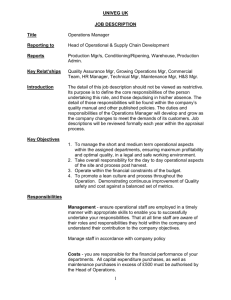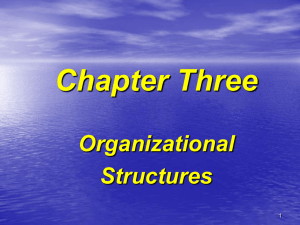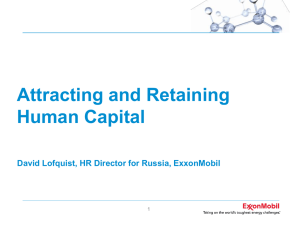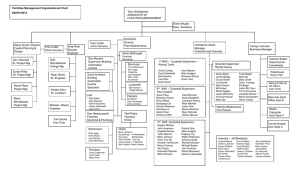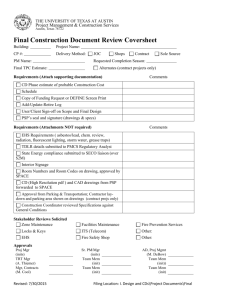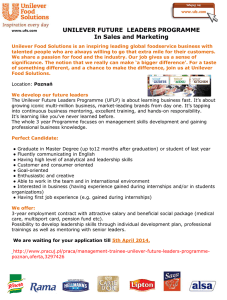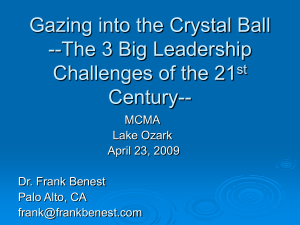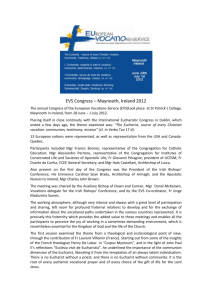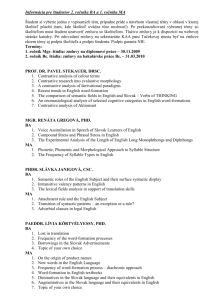Class Session 2 --- Principles & Policies
advertisement
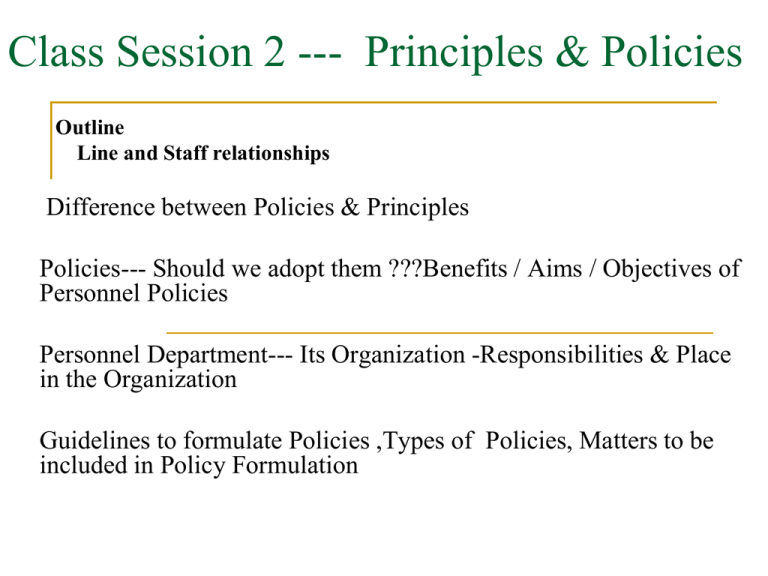
Class Session 2 --- Principles & Policies Outline Line and Staff relationships Difference between Policies & Principles Policies--- Should we adopt them ???Benefits / Aims / Objectives of Personnel Policies Personnel Department--- Its Organization -Responsibilities & Place in the Organization Guidelines to formulate Policies ,Types of Policies, Matters to be included in Policy Formulation Line & Staff Relationships in Organizations Relationship which the managers in an organization deal with one another are classified into two categories Line and staff Line Relationship - authority and responsibility Receiving and giving instructions or orders. Important as one gets work done through people. Staff Relationship –giving and taking of advice Line Staff Relationships in Orgn General Mgr Yellow – Staff Relationship Black – Line Relationship Mkt Mgr Dy Mgr Officer Officer Fin Mgr Dy Mgr Prod.M gr Dy Mgr Officer Officer Sales Asst HR Mgr Dy Mgr Officer Asst Asst Organization of Personnel Department 1. Its concerned with the relationships of management to employees 2. Its concerned with the relationships of employees to employees in all matter 3. Personnel department is staff department and has a structure of line type 4. Organization of personnel function depends on the size, structure, range and depth of actions, needs, capacities, nature and location of organization. 5. The degree to which the organization takes personnel function seriously • Scale of operations large – a separate department is essential Organizational Structure Personnel Department Organizational Structure Personnel Department Personnel Department Personnel Department Eg- Hospitals Personnel Department Eg-FMCG Colgate Palmolive Levels of Management 3 HR Dept Vice President HR 3 Managers ( Functional & General Employees Personnel Department -g- Pharma cos Merck Organization Structure Levels of Management 3 HR Dept Structure Vice President HR Sr. Executive HR Executive HR Responsibility of Personnel Specialist Human Resource Planning Formulation of Programmes & Procedures Employee Health & Safety Programmes Training and Development of Personnel Wage & Salary Administration Good Labour Management Relations – Grievance handling Employee Benefit Programmes Personnel Research Personnel Audit & Review Work Airport Authority of India Functions of Personnel Department Formulating policies & procedure Manpower Planning Training & Development Recruitment & Promotion Service Condition Wage & Salary Administration PAS & Counseling Formulation of various welfare schemes Functional Chart of AAI Chairman Dep't under Board Members OPS Corporate HQ Finance Per &A Finance & A/cs Commercial Internal Audit Land Mgmt Consultancy Secretary Planning Corporate HQ Public Relations Regional HQ Projects Airports Vigilance Personnel Department Indian Oil Corporation Executive Dir HR GM HR DGM HRD T&D HR/Personnel Dept Shoppers Stop VP HR Corporate Mgr HR Training Manager Asst Mgr Training Analyst Officer HR Mastek A mix of functional & Matrix Organization 3 Center Heads Corporate HR Manger Mastek Development Cell Personnel Mgmt OD Training Career Path Oberoi Hotels Sr.VP HR Director HR Training Human Resource Summary HRM is a tool that helps managers to plan, recruit, select, train, develop, remunerate, motivate and make maximum utilization of human and non human resources for the organization and society at large. “One machine can do the work of fifty ordinary men. No machine can do the work of one extraordinary man.”- Elbert Hubbard Principles Principles are fundamental truths related to management of Human Resource established by research, investigation and analysis, generally applicable to all organizations. Henri Fayols’s 14 Principles of Management Division of Work, Authority, Discipline ,Unity of Command, Unity of direction, Centralization Order, Equity, Espirit De Corps ,Stability of Personnel , Initiative , Remuneration, Individual interest Some Personnel Principles: Principle of individual development Principle of free flow of communication Principle of participation Principle of fair remuneration Principle of incentive Principle of scientific selection – right person Principle of Team spirit Some Personnel Principles Principle of lean enterprise –create product or service that has value to customer is of perfect quality & delivery on time Eg – Dabbawalla’s -Their Principles.. Work is Worship Manav seva me bhagwan seva milti hai Unity is strength Principle of poka –yoke – which means error proofing processes Personnel Policies Personnel policies are statements of personal objectives of an organization and provide a broad framework within which decisions on personal matters can be made without reference to higher authorities. They lay down the criteria for decision making in the field of personnel management. Purpose of Principles Principles act as a guide to the managers in formulating policies, programmes, procedures and practices. They help in solving various personnel problems Difference --Policies & Principles Policies Principles A PLAN of Action A fundamental truth established by research, investigation and analysis A statement of intention , more Many principles have been established specific, and commits the management by practice, experience , and to a definite course of action observation It does not spell out a detailed procedure Are facts which cannot be altered A well drafted policy should be flexible and broad enough for it to be applicable to varying situations They come handy in solving many vexing problems since they are universally true. Difference --Policies & Principles Policies It is a guide for managerial decisions and actions Vary from organization to organization Policies must be stable. Policies must reflect goals & values of the organization existing. Principles A guide for managers in formulating policies,programmes,procedur es and practices Applicable to all organizations since they are universally true. Are facts so they would remain facts only Principles do not reflect goals and values of the organization Policies Principles Some egs. – Policy of hiring people Policy on terms and conditions of employment- layoffs, strikes, remuneration hours of work, promotion, housing, uniform, medical assistance etc Some egs – Reuters Values Employee Diversity Building on our longstanding principles of integrity and freedom from bias, we value diversity. Eg ---Privacy Policy of TCS Recruitment Policy of TCS is an equal-opportunity employer Personnel policy of ABB India – states that each employee would understand his role, take responsibility, and develop him according to the changing needs of job profile and organization. Should Organizations Adopt Policies ?? Benefits / Aims / Objectives of Personnel Policies Basic needs of both organization and employees taken care of. Consistent treatment to all the employees Stability & Security of work environment Standard of Performance Builds employee loyalty and motivation Resolves Conflicts -- intrapersonal and interpersonal Guidelines to formulate Policies Sources for determining the content and meaning of policies Past Practice in the organization Prevailing practice in rival companies Attitudes and philosophy of founders of the company, directors and top management Attitudes and philosophy of middle and lower management Knowledge and experience gained from handling countless personnel problems on day-to-day basis Policy Formulation is an essential pre-requisite for manpower planning. Identifying the need – The areas where policy has to be formulated identified. Need for a new policy, revision, or an existing policy is voiced by the staff and members of organization Gathering Information – thru past & prevailing in industry , knowledge and experienced gained from handling problems on day-to-day basis. Examining Policy Alternatives- involving people who use the policy and live with the policies Getting Approval – from the top management at right time. Communicating the Policy - to staff through journals, in house magazines, circulars, meeting, educational programmes etc Evaluating the policy – after the policy is framed it should be evaluated after a certain time period Types of Policies Jucius has identified 2 types Functional or Organizational – policies which are grouped for different categories of personnel eg- for the mgmt dealing with planning, organizing & controlling etc. Centralized – are planned for companies with several locations and are formulated at the Head Office Major Policy – pertain to overall objectives, procedures and control which affect an organization as a whole. They are formulated by the Board of Directors and framework is established within which major executives for the remaining policies necessary to carry out the major objectives of an organization. Minor Policy- cover relationships in a segment of and organization with considerable emphasis on details and procedures. Types of Personnel Policies Originated Policies – established formally by top management Appealed Policies – formulated on requests of subordinates who want to know handle some situations. Imposed Policies – An organization accepts these policies due to external agencies like govt.,trade association . Eg- Not to accept any one below the age of 14 according to the factories act. General Policies – These policies do not relate to specific issues in particular Specific Policies – Policies relating to specific issue like staffing compensation , collective bargaining etc Written or Implicit Policies – are inferred from behavior of managers. Coverage of Policies In most companies, policies are established regarding various functions of personnel management which are as follows:- Coverage of Policies 1)Employment:Employment policies should provide clear guidelines on the following points: a) Minimum hiring qualifications. b) Preferred sources of recruitment c) Reservation of seats for Sc St, handicapped persons and ex-servicemen. d) Probation period e) Lay off and rehiring Eg – Minimum qualification for cabin crew is HSC Eg – Banks have reservation systems for employees Eg – BMC , Police departments , Armed Forces Coverage of Policies 2) Training and Development a) Attitude towards training b) Objectives of training c) Basis of training d) Methods of training e) Programmes for executive development f) Orientation of new employees Eg- Armed Forces, Police Department, Fire Departments, Disaster Management Dept Coverage of Policies 3) Transfers and Promotions a) Rationale for transfer b) Seniority required for promotion c) Relative weightage of seniority and merit in promotion Eg- Police constables are transferred to urban cities if they belong to some interiors of Maharashtra Coverage of Policies 4. Compensation a) Job evaluation system b) Minimum wages and salaries c) Method of wage payment d) Profit sharing and incentive plans e) Non monetary rewards Coverage of Policies 5. Working Conditions a) Working hours b) Number and duration of rest intervals c) Overtime work d) Shift work e) Safety rules and regulations f) provision of transportation etc Eg – Tesco paid salaries on hourly basis and time taken off for tea break was not included in total working hours. The company reduced 15 minutes of wages from employees who were late by three minutes. The company did not pay for the first 3 days of sick leave taken by employees and dismissed employees who took many sick leaves Eg – A poultry unit of US does not let the employees use the freshroom because its an assembly line structure. An employee would use the freshroom when the reliever relieves him Coverage of Policies 6. Industrial Relations a) Handling of grievances b) Recognition of Trade union c) Suggestion Schemes d) Discipline and Conduct rules- Punctuality, smoking and drinking e) Workers participation – through quality circles, total quality management etc Matters to be included in Policy Formulation •History of company’s growth •Employment practices and conditions of employment •Grievance redressal procedure •Safety rules and regulations and responsibilities of employees at work •General Practices •Mutuality of interests •Employee financial Aid •Educational Aids •Employees news sheet and house journals •Health & Hospitalization •Vacation with pay •Sickness, death and maternity benefits and allowances •Prohibited Activities •Labour Management & Industrial Relations etc Nike’s Principles Minimizing impact on environment There would be no discrimination based on race, creed, gender and marital status or maternity status age etc The manufacturer would not have children employed below the age of 18 to produce footwear. P &G s Principles We show respect for all individuals We believe that all individuals can and want to contribute to their fullest potential We value personal mastery We believe it is the responsibility of all individuals to continually develop themselves and others We seek to Be the Best We strive to be the best in all areas of strategic importance to the Company Innovation is a corner stone of Our Success We place great value on big, new consumer innovations TESCO’s Principle Lean Thinking is a way of working which increases value through the elimination of waste. It has guided our supply chain thinking for over six years. Womack and Jones define waste as: Errors, Overproduction, Waiting for people, equipment or materials, excess stock, dissatisfied customers ….And suggest an approach to reducing waste.. Specifying value by defining the value a customer places on an good or service Lining up all the value creating activities or a product along a value stream which reduces the eight wastes Making value flow smoothly through the pull of the customer in pursuit of perfection Uni lever’s business principles Standard of Conduct We conduct our operations with honesty, integrity and openness, and with respect for the human rights and interests of our employees. We shall similarly respect the legitimate interests of those with whom we have relationships. Obeying the Law Unilever companies and employees are required to comply with the laws and regulations of the countries in which we operate. Employees Unilever is committed to diversity in a working environment where there is mutual trust and respect and where everyone feels responsible for the performance and reputation of our company. We will recruit, employ and promote employees on the sole basis of the qualifications and abilities needed for the work to be performed. We are committed to safe and healthy working conditions for all employees. We will not use any form of forced, compulsory or child labour. We are committed to working with employees to develop and enhance each individual's skills and capabilities. We respect the dignity of the individual and the right of employees to freedom of association. We will maintain good communications with employees through company based information and consultation procedures. Conflicts of Interests All Unilever employees are expected to avoid personal activities and financial interests which could conflict with their responsibilities to the company. Unilever employees must not seek gain for themselves or others through misuse of their positions. Compliance – Monitoring – Reporting Compliance with these principles is an essential element in our business success. The Unilever Board is responsible for ensuring these principles are communicated to, and understood and observed by, all employees. Day-to-day responsibility is delegated to the senior management of the regions and operating companies. They are responsible for implementing these principles, if necessary through more detailed guidance tailored to local needs. Assurance of compliance is given and monitored each year. Compliance with the Code is subject to review by the Board supported by the Audit Committee of the SUMMARY Family friendly policies should live up and not exist on paper Men and women at all levels of companies in all stages of their career development and all stages of their life cycle are seeking flexibility to achieve a better work life balance Family friendly policies are one way to support and recognize the changing needs of employees
